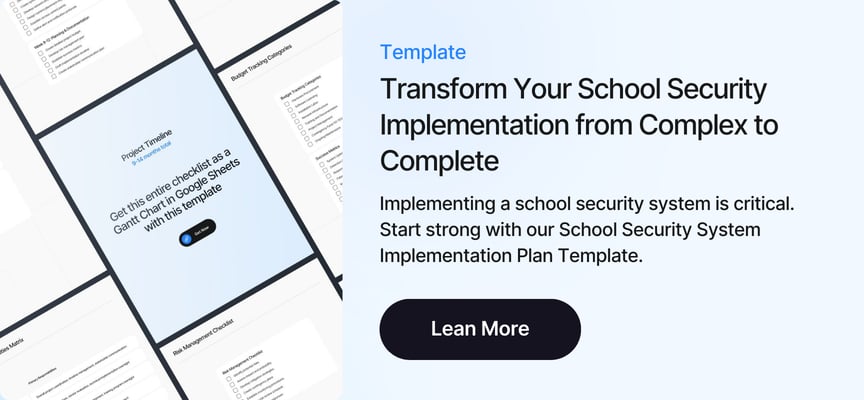Key Points
- Immediate Response Capability: AI-powered person-down detection enables medical emergency response within 15-45 seconds, compared to traditional methods that may take several minutes
- Life-Saving Technology: Real-time detection of medical emergencies like asthma attacks, seizures, and cardiac events can prevent minor incidents from becoming life-threatening emergencies
- Comprehensive Coverage: AI systems monitor 100% of camera feeds 24/7, detecting medical emergencies in areas where staff may not be present
- Integration with Existing Infrastructure: Person-down detection technology works with existing security cameras, requiring no hardware replacement
- Privacy-Focused Monitoring: Systems analyze behaviors and movement patterns without using facial recognition technology
- Multi-Event Detection: Beyond medical emergencies, these systems also detect fights, unauthorized access, and security threats through the same infrastructure
Every day, school administrators face a sobering reality that extends far beyond academic concerns. Medical emergencies are common occurrences in schools, with over 506,500 EMS responses to schools occurring between 2018 and 2022. In the 2023-2024 school year, an estimated 2.4 million students were transported from schools to emergency rooms across the U.S. for various medical reasons. These statistics underscore a critical challenge facing educational institutions: how to detect and respond to medical emergencies before they become life-threatening situations.
The stakes could not be higher. Emergency services aim to respond to 911 calls within 6 minutes or less, but according to RapidSOS, "For every minute delay in primary response for certain life-threatening medical emergencies, there is a measurable effect on mortality." This reality places enormous pressure on school staff to identify and respond to medical emergencies with speed and precision that can mean the difference between life and death.
Learn how real public schools have implemented VOLT AI.
The Hidden Crisis in School Medical Emergencies
Schools serve as more than educational institutions. They function as temporary guardians for millions of students who spend significant portions of their day under school supervision. Children with special health care needs carry additional risks of emergencies related to their diagnoses, and 19 percent of children have special health care needs. This growing population requires heightened vigilance and faster response capabilities than traditional school safety measures can provide.
Neurologic problems like seizures accounted for 19% of EMS calls to schools, while injuries caused by accidents or mishaps accounted for another 15%. These incidents often occur suddenly and without warning, presenting unique challenges for school staff who must balance educational responsibilities with emergency response duties.
Traditional emergency response methods in schools face significant limitations. A teacher leaving a classroom leaves students unsupervised, which is another risk. Relying on a student to go for help could fail if the student panics, gets lost, or doesn't properly convey the situation. Even when communication systems work perfectly, precious seconds and minutes can be lost during the critical early stages of a medical emergency.
The geographic reality of school campuses compounds these challenges. CENTEGIX's 2023 Spring Term School Safety Trend Report found that nearly 50% of incidents happen outside of the classroom, making traditional intercom systems and landline phones ineffective for many emergency situations.
Watch our On-Demand Webinar about how K-12 Public Schools are using VOLT AI.
Critical Response Time Gaps
Traditional medical emergency detection in schools creates dangerous delays that can prove fatal:
- Teacher notification delay: Staff must recognize emergency, leave classroom or send student messenger (2-5 minutes)
- Administrative response: Office staff must locate appropriate personnel and emergency contacts (3-7 minutes)
- External emergency services: 911 dispatch and EMS arrival times (6-12 minutes average)
- Location identification: First responders must navigate campus and locate specific emergency site (additional 2-4 minutes)
The Technology Revolution: AI-Powered Person-Down Detection
Artificial intelligence has fundamentally transformed how schools can detect and respond to medical emergencies. AI-powered person-down detection technology represents a paradigm shift from reactive to proactive emergency management, offering schools the ability to identify medical emergencies the moment they occur.
Person-down detection technology analyzes video feeds in real-time, using sophisticated algorithms to distinguish between normal activities and genuine medical emergencies. The technology identifies specific movement patterns, body positioning, and environmental context that indicate when someone has fallen or is in medical distress.
Core Detection Capabilities
Modern AI systems provide comprehensive medical emergency detection through multiple analysis methods:
- Body positioning assessment: Distinguishes between intentional lying down and emergency situations
- Multi-camera coordination: Tracks individuals across camera zones for comprehensive coverage
- Real-time verification: Human validation ensures accuracy while maintaining rapid response times
Integration capabilities extend the technology's effectiveness beyond simple detection. Modern AI school security systems can automatically notify designated staff members, contact emergency medical services, and provide precise location information to first responders.
Real-World Impact: Lives Saved Through Technology
The true measure of person-down detection technology lies in its real-world performance during actual medical emergencies. Schools implementing these systems report dramatic improvements in response times and outcomes for students experiencing medical distress.
Adam Neely, Principal at Prescott High School in Arizona, experienced the life-saving potential of this technology firsthand. "I got a notification on my watch. I quickly looked and it said person down and I saw where it was and there was no one around. So I quickly just kind of got myself out there. I found a young lady who was against the wall. She looked slightly in distress, nothing over the top, but she was having an asthma attack."
The AI system detected the student's distress in an empty hallway where no staff member would have seen her. Neely was able to respond within 45 seconds, providing immediate assistance and ensuring the student received appropriate medical care. "No one would've been able to see this young lady, but this system noticed her and to me that was huge," Neely explained.
Documented Response Time Improvements
Schools implementing AI-powered person-down detection report significant response time improvements across multiple emergency scenarios:
- Initial detection: Reduced from variable timing to immediate (under 5 seconds)
- Staff notification: Decreased from 2-5 minutes to 5-15 seconds
- On-site response: Improved from 5-10 minutes to 30-60 seconds
- Emergency coordination: Enhanced from manual processes to automated systems
- Documentation creation: Automated incident recording versus manual report generation
Enhanced Emergency Response Integration
Person-down detection technology extends far beyond simple identification of medical emergencies. Modern AI systems provide comprehensive support for emergency response procedures, offering schools multiple layers of protection and assistance during critical situations.
Immediate notification capabilities ensure that appropriate personnel receive alerts within seconds of detection. Systems can be configured to notify specific staff members based on the type and location of the emergency, ensuring that the most qualified responders receive immediate alerts.
Integration with emergency communication systems enables automatic activation of broader emergency response protocols. When a medical emergency is detected, AI systems can trigger announcements, contact emergency medical services, and coordinate with local first responders.
Feature | Traditional Response | AI-Powered Response |
Detection Time | Variable (depends on witness presence) | Immediate (seconds) |
Alert Delivery | Manual (phone calls, runners) | Automatic (multi-channel) |
Location Accuracy | General area description | Precise camera location |
Response Coordination | Manual communication | Automated system integration |
Documentation | Manual incident reports | Automatic video evidence |
Staff Availability | Must be present to detect | Continuous monitoring |
Coverage Areas | Limited to staffed locations | 100% camera coverage |
Strategic Implementation Framework
Successfully implementing person-down detection technology requires careful planning and consideration of multiple factors that impact both effectiveness and acceptance within the school community. School leaders must address technical, operational, and social considerations to ensure optimal outcomes.
Technical integration begins with assessment of existing camera infrastructure and coverage areas. Schools need to evaluate which areas require medical emergency detection capability and ensure adequate camera coverage in critical locations.
Implementation Planning Checklist
School leaders should address these critical areas during AI security camera implementation:
- Infrastructure Assessment: Evaluate existing camera coverage, network capacity, and integration requirements
- Staff Training Programs: Develop comprehensive training for emergency response, system operation, and protocol updates
- Community Communication: Create transparent messaging about system capabilities, privacy protections, and safety benefits
- Response Protocol Updates: Establish clear procedures for alert verification, escalation pathways, and emergency coordination
- Testing and Validation: Implement regular system testing, emergency drills, and performance monitoring
- Privacy Compliance: Ensure adherence to student privacy laws, data protection requirements, and community standards
Staff training represents a critical success factor for person-down detection implementation. All relevant personnel must understand how the system works, what types of alerts they may receive, and appropriate response procedures for different emergency scenarios.
Emergency response procedures must be updated to incorporate AI-powered detection capabilities. Schools need to establish clear protocols for responding to automated alerts, including verification procedures, escalation pathways, and communication with emergency medical services.
Performance Metrics and Success Measurement
The effectiveness of person-down detection technology can be measured through multiple metrics that demonstrate both immediate response improvements and long-term safety outcomes. Schools implementing these systems should establish baseline measurements and track key performance indicators to assess technology impact.
Response time metrics provide the most direct measurement of system effectiveness. Schools should track the time from emergency occurrence to first responder arrival, comparing pre-implementation and post-implementation performance.
Detection accuracy measurements help schools understand system reliability and identify opportunities for improvement. Schools should track true positive detection rates, false positive occurrences, and any missed emergency situations. Modern systems also focus on false alarm reduction to prevent alert fatigue among staff.
Key Performance Indicators
Essential metrics for evaluating person-down detection system effectiveness include:
- Response Time Reduction: Measure improvement in detection-to-response intervals across different emergency types
- Detection Accuracy Rates: Track true positive alerts versus false positive occurrences for system reliability assessment
- Coverage Effectiveness: Monitor emergency detection across different campus areas and time periods
- Staff Confidence Levels: Survey staff regarding their confidence in emergency response capabilities
- Emergency Outcome Improvement: Assess incident severity, medical transport requirements, and patient outcomes
- Cost-Benefit Analysis: Calculate return on investment through liability reduction, outcome improvements, and operational efficiency
Return on Investment and Value Proposition
The financial and operational benefits of person-down detection technology extend far beyond initial implementation costs. Schools implementing these systems typically experience positive returns on investment within the first year of operation through multiple value streams.
Cost savings emerge from reduced liability exposure, improved emergency outcomes, and enhanced operational efficiency. Schools report decreased emergency response costs, reduced staff time spent on incident investigation, and lower insurance premiums due to enhanced safety measures.
Operational improvements include better resource allocation, more efficient emergency response coordination, and enhanced overall safety culture. Staff confidence increases significantly when they know that medical emergencies will be detected automatically, even in areas where direct supervision is limited. Understanding school security system costs helps administrators make informed decisions about technology investments.
Financial Impact Analysis
Schools should consider both direct and indirect financial benefits when evaluating person-down detection implementation:
- Direct Cost Savings: Reduced emergency response costs, lower insurance premiums, decreased liability exposure
- Operational Efficiency: Improved staff productivity, reduced investigation time, enhanced resource allocation
- Risk Mitigation: Prevention of serious injury complications, reduced medical transport costs, enhanced safety reputation
- Long-term Value: Improved enrollment retention, enhanced community confidence, reduced staff turnover
- Compliance Benefits: Meeting safety regulations, addressing duty of care requirements, demonstrating due diligence
The urgency of implementing person-down detection technology extends beyond simple safety improvements. Schools face increasing expectations from parents, communities, and regulatory bodies to provide comprehensive emergency preparedness.
Legal and liability considerations make person-down detection technology increasingly essential for educational institutions. Schools have a duty of care to provide safe environments for students and staff, and failure to implement available safety technologies could expose institutions to significant legal risk.






